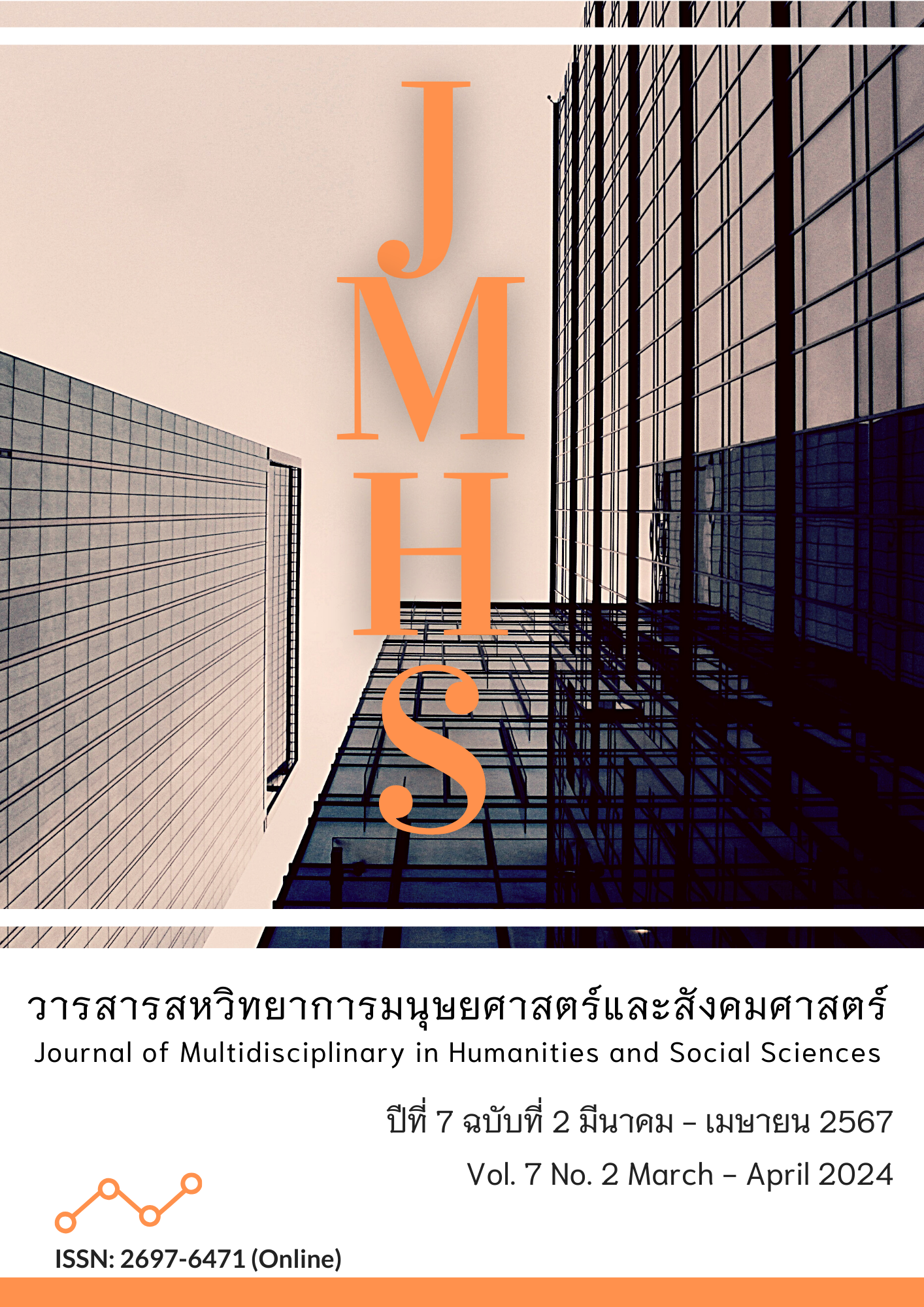Guidelines for Development of Innovative Leadership for School Administrators under Secondary Educational Service Area Office Mukdahan
Main Article Content
Abstract
This article aimed to: 1) study the current and desirable situations for innovative leadership for school administrators; 2) assess the needs for innovative leadership for school administrators; 3) develop guidelines for innovative leadership for school administrators; and 4) assess the suitability and possibility of guidelines for the development of innovative leadership for school administrators. The research area was schools under the secondary educational service area office in Mukdahan. The sample group consisted of 252 school administrators and teachers who followed the percent criterion in the sample size specification, and they were selected by multi-stage random sampling. There were three research instruments: (1) a questionnaire; (2) a structured interview form; and (3) a suitability and possibility assessment form. The statistics employed in data analysis were percentage, mean, standard deviation, and Modified Priority Needs Index (PNIModified).
The research results were as follows: 1) The overall current situations and desirable situations for innovative leadership for school administrators were at the high level and the highest level, respectively; 2) the needs were higher than the overall value, namely visionary, creative thinking, and innovative leadership; 3) The overall development guidelines consisted of six aspects, as follows: (1) visionary; (2) taking risks; (3) teamwork and participation; (4) having creative thinking; (5) creating an innovative organizational atmosphere; and (6) having an innovative leadership personality, which consisted of 31 guidelines; and 4) the results of the overall development evaluation revealed that the suitability was at the highest level and the possibility was at the highest level.
Article Details

This work is licensed under a Creative Commons Attribution-NonCommercial-NoDerivatives 4.0 International License.
Views and opinions appearing in the Journal it is the responsibility of the author of the article, and does not constitute the view and responsibility of the editorial team.
References
กนกพิชญ์ สรรพศรี และ พชรวิทย์ จันทร์ศิริสิร. (2565). การพัฒนาโปรแกรมเสริมสร้างภาวะผู้นําเชิงนวัตกรรมของผู้บริหารสถานศึกษาในศตวรรษที่ 21 สังกัดสำนักงานเขตพื้นที่การศึกษาประถมศึกษากาฬสินธุ์ เขต 1. วารสารพุทธปรัชญาวิวัฒน์, 6(1), 27-38.
กนกวรรณ จันทรนิมะ, อมร มะลาศรี และ สุพจน์ ดวงเนตร. (2565). การศึกษาภาวะผู้นำและแนวทางการพัฒนาภาวะผู้นำเชิงนวัตกรรมของผู้บริหารโรงเรียน สังกัดสำนักงานเขตพื้นที่การศึกษาประถมศึกษาชัยภูมิ เขต 2. วารสารการบริหารการศึกษาและภาวะผู้นำมหาวิทยาลัยราชภัฏสกลนคร, 10(39), 93-101.
กุลชลี จงเจริญ. (2562). ภาวะผู้นำเชิงนวัตกรรม. เอกสารประกอบการสอน. นนทบุรี: มหาวิทยาลัยสุโขทัยธรรมาธิราช.
ฐิตินันท์ นันทะศรี, วาโร เพ็งสวัสดิ์, วัลนิกา ฉลากบาง และ พรเทพ เสถียรนพเก้า. (2562). การพัฒนาตัวบ่งชี้ภาวะผู้นำเชิงนวัตกรรมของผู้บริหารสถานศึกษา สังกัด สำนักงานเขตพื้นที่การศึกษาประถมศึกษาในภาคตะวันออกเฉียงเหนือ. วารสารวิชาการและวิจัยสังคมศาสตร์, 14(3), 93-105.
ตรี ภูวิโคตรธนกุล, วัลลภา อารีรัตน์ และ ประกฤติยา ทักษิโณ. (2562). โมเดลภาวะผู้นำของผู้บริหารสถานศึกษาที่ส่งผลต่อสมรรถนะครูในการจัดการเรียนรู้ตามแนวสะเต็มศึกษา : โมเดลแข่งขันภาวะผู้นำเชิงนวัตกรรมและภาวะผู้นำเชิงวิชาการ. วารสารบริหารการศึกษามหาวิทยาลัยขอนแก่น, 15(2), 70-84.
นภาพร ศรีสุคันธพฤกษ์, จอมพงศ์ มงคลวนิช และ ปองสิน วิเศษศิริ. (2566). แนวทางการพัฒนาภาวะผู้นําเชิงนวัตกรรมของผู้บริหารสถานศึกษาสังกัดสำนักงานเขตพื้นที่การศึกษามัธยมศึกษากรุงเทพมหานคร. วารสารสังคมศาสตร์และวัฒนธรรม, 7(3),117-131.
นาวิน นิลแสงรัตน์, สรายุทธ์ เศรษฐขจร และ วิชาญ สาคุณ. (2564). การพัฒนาภาวะผู้นําเชิงนวัตกรรมของผู้บริหารมหาวิทยาลัยในภาคกลาง. วารสารวิชาการสถาบันเทคโนโลยีแห่งสุวรรณภูมิ, 7(2), 497-509.
พรพิมล อินทรรักษา (2562). แนวทางการพัฒนาภาวะผู้นำเชิงนวัตกรรมของผู้บริหารสถานศึกษา สังกัดสำนักงานเขตพื้นที่การศึกษาประถมศึกษานครศรีธรรมราชเขต 4. วารสารพุทธสังคมวิทยาปริทรรศน์, 6(3), 122.
พิสิฐธวัฒน์ กลิ่นไธสงค์, ถนอมวรรณ ประเสริฐเจริญสุข และ อัจศรา ประเสริฐสิน. (2559). การพัฒนาตัวบ่งชี้ภาวะผู้นำเชิงนวัตกรรมของผู้บริหารโรงเรียนมัธยมศึกษา สังกัดสำนักงานเขตพื้นที่การศึกษามัธยมศึกษา. วารสารบริหารการศึกษา, 12(1), 177-186.
ไพฑูรย์ สินลารัตน์. (2555). หลักและเทคนิคการสอนระดับอุดมศึกษา. (พิมพ์ครั้งที่ 3). กรุงเทพฯ: จุฬาลงกรณ์มหาวิทยาลัย.
รัตติกรณ์ จงวิศาล. (2556). ภาวะผู้นำ : ทฤษฎีการวิจัยและแนวทางสู่การพัฒนา. กรุงเทพฯ: จุฬาลงกรณ์มหาวิทยาลัย.
ลฎาภา นาคคูบัว และ จันทรัศม์ ภูติอริยวัฒน์. (2564). การพัฒนาตัวบ่งชี้ภาวะผู้นำเชิงนวัตกรรมของผู้บริหารสถานศึกษาในพื้นที่นวัตกรรมการศึกษา. วารสารวิจัยและพัฒนาหลักสูตร, 12(1), 1-12.
ศุภิญญากิจ เกตุวิเศษกูล และ ไพบูลย์ ลิ้มมณี. (2563). การพัฒนาโปรแกรมเสริมสร้างภาวะผู้นำเชิงนวัตกรรมของผู้บริหารสถานศึกษาเอกชน ประเภทสามัญศึกษา สังกัดสำนักงานคณะกรรมการส่งเสริมการศึกษาเอกชน จังหวัดกาฬสินธุ์. วารสารวิชาการธรรมทรรศน์. 20(3), 49-60.
สนธยา พลศรี. (2547). ทฤษฎีและหลักการพัฒนาชุมชน. (พิมพ์ครั้งที่ 5). กรุงเทพฯ: โอเดียนสโตร์.
สุธิดา สอนสืบ และ พชรวิทย์ จันทร์ศิริสิร. (2565). โปรแกรมเสริมสร้างภาวะผู้นำเชิงนวัตกรรมของผู้บริหารสถานศึกษาในยุคดิจิทัล สังกัดสำนักงานเขตพื้นที่การศึกษามัธยมศึกษาอุบลราชธานี อำนาจเจริญ. วารสารพุทธปรัชญาวิวัฒน์, 6(2), 212-225.
สุนทร โคตรบรรเทา. (2560). การบริหารการศึกษาหลักการและทฤษฎี (ฉบับปรับปรุง). กรุงเทพฯ: ปัญญาชน.
สำนักงานเขตพื้นที่การศึกษามัธยมศึกษามุกดาหาร. (2565, 25 ธันวาคม). รายงานผลการดําเนินงานตามแผนปฏิบัติการประจำปีงบประมาณ พ.ศ. 2565 สำนักงานเขตพื้นที่การศึกษามัธยมศึกษามุกดาหาร. สืบค้นเมื่อ 25 กรกฎาคม 2566, จาก https://www.sesaomuk.go.th/o12-65.
Avolio, B. J., & Mhatre, K. H. (2011). Advances in Theory and Research on Authentic Leadership. Oxford: Oxford University Press.
Carmeli, A., Gelbard, R., & Gefen, D. (2010). The Importance of Innovation Leadership in Cultivating Strategic Fit and Enhancing Firm Performance. The Leadership Quarterly, 21(3), 339-349.
Daft, R. L. (2008). New Era of Management. (2nd ed). China: China Translation and Printing Services.
Dotlich, D.L., & Noel J.L. (1998). Action Learning: How the World’s Top Companies are Re-Creating Their Leaders and Themselves. San Francisco, CA: Jossey-Bass.
Dubrin, A. J. (2004). Leadership: Research Findings, Practice, and Skills. (4th ed). New York: McGraw-Hill.
Fuad, D. R. S. M. et al. (2021). The Development and Validation of the Principal Innovation Leadership Scale in Malaysian Secondary Schools. International Journal of Evaluation and Research in Education (IJERE), 11(1), 193-200.
Fullan, M., & Stiegelbauer, S. (1995). The New Meaning of Education Change. (2nd ed). London: Cassell.
Horth, D., & Buchner, D. (2014). Innovation Leadership: How to Use Innovation to Lead Effectively, Work Collaboratively and Drive Results. Center for Creative Leadership. Open Journal of Leadership, 10(3), 18.
Hunter, S. T., & Cushenbery, L. (2011). Leading for Innovation: Direct and indirect influences. Advances in Developing Human Resources, 13(3), 248-265.
Imaginnationcomau. (2016, March 7). 8 Reasons Why Innovation is Important to Businesses Today. Retrieved April 20, 2023, from http://www.imaginenation.com.au/innovation-blog/8-reasons-innovation-important-businesses-today/.
Loader, A. (2016). Why Should You Show Innovative Leadership?. Retrieved April 28, 2023, from https://blog.castle.co/innovative-leadership.
Pagaura, A. R. (2020). Innovative Leadership Attributes of School Administrators in the Philippines: Implications for Educational Management. Interdisciplinary Research Review, 15(2), 1-7.
Sen, A., & Eren, E. (2012). Innovative Leadership for the Twenty-First Century. Social and Behavioral Science, 41(3), 1-14.
Stoner, J.A.F., & Charles, W. (1986). Management. (3rd ed). New Jersey: Prentice Hall.
Ubaidillah, M. (2018). Innovation Leadership in Improving the Quality of Education. International Journal of Mechanical Engineering and Technology, 9(7), 1288-1299.
Weiss, S.D., & Legrand, C. (2011). Innovative Intelligence. Ontario: John Wiley and Sons.


